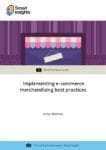Legendary American football coach Vince Lombardi said it best: ‘Practice does not make perfect. Only perfect practice makes perfect.’
If you’re running around like crazy - doing redesigns, running split tests, and adding new technologies - but don’t know the best practices needed to define the ‘most likely to succeed’ designs and tests - you’re definitely not practicing perfectly. And you’re leaving a lot of potential revenues on the table.
Don’t succumb to constant guessing: plan and execute your online merchandising tactics based on proven best practices.
Types of best practices
Best practices in e-commerce certainly cover a wide spectrum. In this post, I will focus on the user experience design tactics most likely to lift your core metrics: add-to-carts, conversion rates, and revenues.
The best practices you should be implementing right now include:
- Optimizing product findability
- Optimizing your category pages
- Optimizing your product pages
Optimizing product findability
What the heck does ‘findability’ mean? It just means making it easier for your prospect to find the product they want, whether they’re an early-stage shopper, have narrowed down thier choices, or is ready to buy now.
This is an exciting era for user experience design because web interactions are highly dynamic. We no longer have to enter search keywords, press Enter, then cross our fingers and wade through reams of results. Search functions can now automatically complete our queries, effectively ‘reading our minds’ on what we want to find. Best of all, courtesy of Asynchronous JavaScript, the search results can be served up immediately.
And the results can come to life, in the form of visual thumbnails, with accompanying brief descriptions. Your visitors no longer need to drill down to see the information they want to know to make a decision.
Retailers like Claire’s and The Fragrance Shop do a great job of this, by showing relevant results visually and in a variety of ways: from direct results to branded results and related categories. The technology exists, so plug it in soon and start seeing an immediate conversion lift.
Optimize your category pages
My experience has shown that your category pages are one of the best places to educate your early-stage prospects. They’re a place to do it visually and thus more memorably than with conventional copy.
First, by highlighting new, featured, and previously-viewed products you can boost your revenues and profit margins. You can tailor what you show based on your recommendations engine.
Second, by scripting, producing, and posting ‘explainer’ videos, you can inform your prospect about key product features to consider. Just as importantly, you can take a few seconds to share your brand’s value proposition. Best sure to keep these videos relatively short (less than 4-5 minutes); longer videos will challenge your visitors’ attention spans. And best sure to review your draft videos with a few sample prospects to make sure they hit the mark.
Lastly, by offering most-wanted filters like brand, size, and colour prominent on category pages, you can allow your prospect to quickly narrow down their choices. And less choice is usually better when it comes to e-commerce conversions and sales. You’ll also be saving your prospect's time, which has become a very scarce resource these days.
Optimize your product pages
The product page is the nexus of your online selling efforts; it’s here that you either get your prospect to click the ‘add to cart’ button or you don’t. So, on this page, you need to use all the persuasion tricks in your toolbox.
You need to show your product from multiple angles, allowing your visitor to zoom in and out. Allow your prospects to easily ‘swipe through’ the images on mobile devices.
Carrying the video theme over from the category pages, you should include product demo videos, at least for your best-selling products. This lets your prospects visualize themselves already owning it. The latest neuroscience research has shown that if we humans see a product in action, and feel it viscerally, they’re as good as sold on it.
We know from top salespeople that benefits sell better than features and specs. Your prospects want to see ‘what this will do for me’ more than everything you as the seller know about it. This 180-degree, customer-first mentality should pervade all of your merchandising efforts.
Finally, because people are highly social animals always seeking cues from others, don’t forget to include social validation in the form of customer reviews and kudos from outside organizations.
Use best practices for best results
Don’t let the thousands of hours of creative and testing effort of years past go to waste. Learn the e-commerce best practices and put them into practice ASAP!
You’ll soon see your engagement, conversion rate, and revenues rise!







